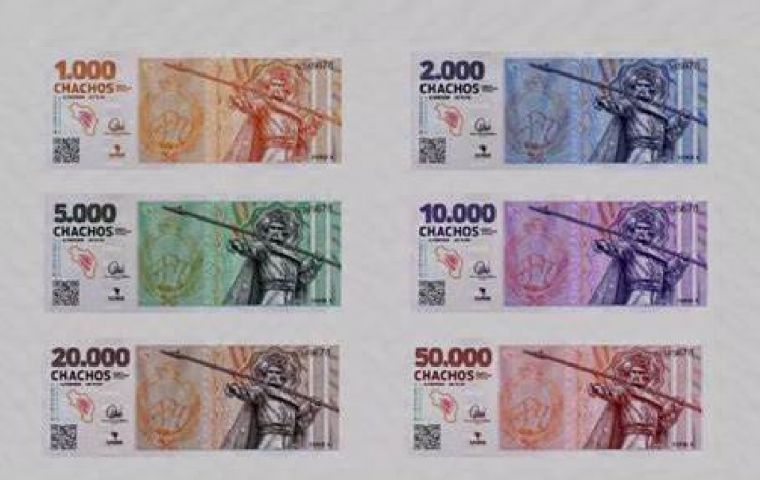MercoPress. South Atlantic News Agency
Argentine province has its own money... again
 Large-denomination Chachos might come in more handy for hefty transactions
Large-denomination Chachos might come in more handy for hefty transactions The Argentine province of La Rioja finally made do with its promise to issue a pseudo-currency of its own to meet debts within its territory. Officially named Debt Cancellation Bonds (Bocade), La Rioja's money is better known as “Chacho” whereby “1 Chacho = 1 Argentine peso.”
Chachos are used to pay 30% of the salaries of public administration workers and to cover other provincial expenses. In 2001, La Rioja had already used the same mechanism to counter the scarcity of pesos. The province's legislature had approved the new issuance of Chachos in January this year.
This time around the province will be issuing AR$ 15 billion worth of chachos given the federal government's failure to send AR$ 9.3 billion, due to which Governor Ricardo Quintela has also sued President Javier Milei's government before the Supreme Court which has original jurisdiction in these matters.
“We are forced to this because of the speed, the savagery, the cruelty of the adjustment that was precipitated in 20 days,” Quintela argued.
Chachos are also to be accepted at any store adhering to the provincial government's program or by any provincial state agency which would include water and electricity companies.
With banknotes worth 1,000, 2,000, 5,000, 10,000, 20,000, and 50,000 Chachos to be minted, they might become more useful than pesos for large amounts considering that the country's highest bill is worth AR$ 10,000.
Quintela also hoped that the circulation of Chachos would reinvigorate the province's waning economy. “It is an instrument designed to boost the local financial circuit, reactivating the economy and consumption,” he said.
The Riojan government also pointed out that all businesses may receive these bonds, but may not add any surcharge or receive them for a lesser value.
“To think that during the election campaign, I was treated as crazy for postulating a system in which there was free currency competition, and now they are promoting it!” President Javier Milei wrote on X from Davos when La Rioja first announced the initiative.
“Welcome the provincial currencies to the competition, which, I would like to point out, unlike what happened in the past, will in no way be rescued by the national government,” he added. “The nation had to face the correction of a deficit of 15% of GDP, while all the provinces together add up to 1% of GDP,” the President added back then. “With such an advantage, unless they are very bad, they should be quoted far above par,” he said.
As per Argentina's Constitution, only the federal government may issue money. However, similar measures were adopted by numerous provinces during the 2002 crisis, claiming chachos or patacones (the unit used then by the Province of Buenos Aires) were not money but bonds.
Chachos were named after General Ángel Vicente Peñaloza (1798–1863) -a.k.a. “El Chacho,” one of the last caudillos to revolt against Buenos Aires' centralism. In November 1863 after a military defeat, he surrendered to Major Pablo Irrazábal, who killed him with his spear and ordered his soldiers to fill the body with bullets. His head was cut off and nailed to the top of a post at a square in the presence of his family. His wife, Victoria Romero, was forced to sweep the main square of the city of San Juan in shackles.




Top Comments
Disclaimer & comment rules-

Read all commentsAs if Argentine money isn't “funny” enough...
Jul 06th, 2024 - 01:26 am 0Commenting for this story is now closed.
If you have a Facebook account, become a fan and comment on our Facebook Page!